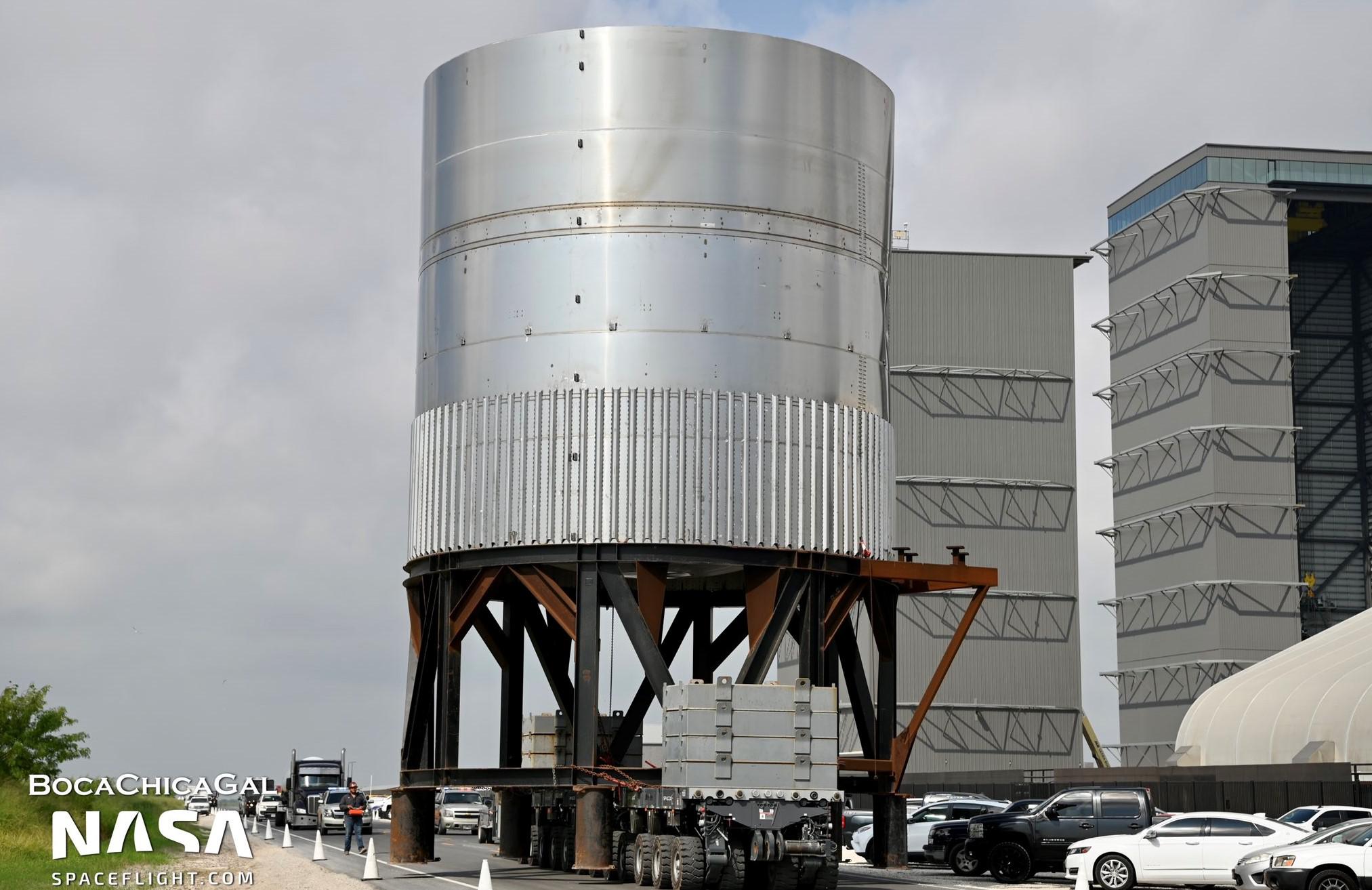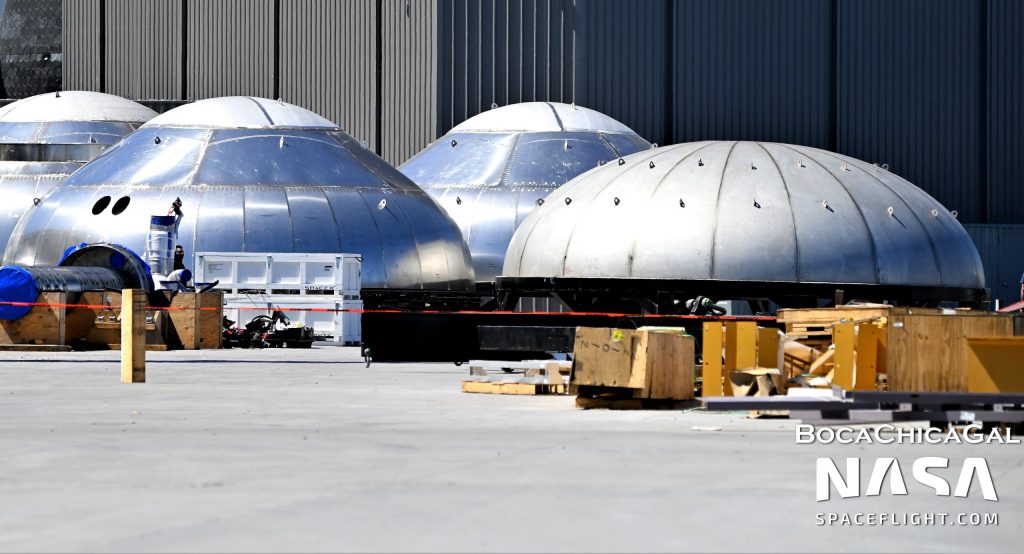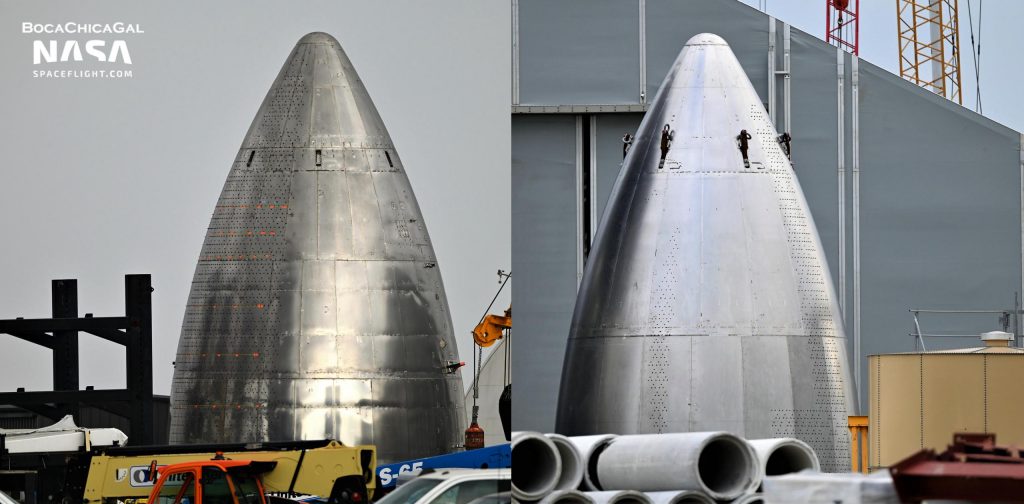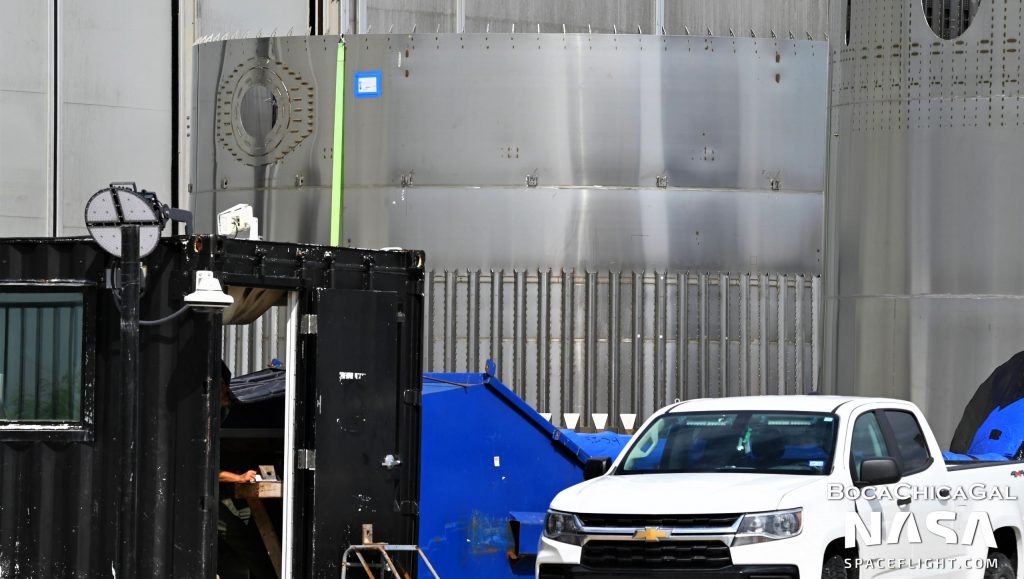

News
SpaceX rolls out Starship tank prototype to test upgraded domes
Several months after the first prototype was spotted floating around Starbase, SpaceX has finished assembling a tank designed to put upgraded Starship domes to the test.
Known only as “EDOME” per a tracking label taped to its side, the prototype looks fairly ordinary from the outside and could easily be mistaken for just the latest in a long line of nine ‘test tanks’ SpaceX has already built, tested, and sometimes destroyed. However, under its ordinary exterior of nine-meter (30 ft) wide steel rings and stringers, there are two tank domes that represent a significant design departure from the dozens of domes SpaceX has built and tested over the last two years. Much like a new nosecone design that SpaceX only began testing for the first time a matter of days ago, a large part of the dome redesign was focused on making them much easier to build.
Work on the first upgraded Starship nose prototypes began in earnest around the turn of the new year. Starship’s upgraded domes took a bit longer, with a completed prototype appearing for the first time in mid-March. To an extent, the new dome went even further than SpaceX’s slightly more modest nose redesign, drastically simplifying the structure into just one main component. Whereas the nose redesign simplified nose assembly from five to three different stacked sets of welded ‘gores,’ or tapering slices of metal, SpaceX’s dome redesign appears to have more or less reduced the number of stacked sections from three to one.


The new dome design should only require 18 ‘gores’ and one small cap, compared to the roughly 40 different pieces and three ‘stacks’ needed for each older dome. Thanks to the new dome’s more hemispherical shape, SpaceX has also managed to improve the efficiency of the design while still making it far easier to assemble. Despite being significantly more compact than the old design, the new dome should still be able to hold roughly the same amount of propellant as the old dome.
SpaceX finished assembling the first “EDOME” test tank sometime in late May or early June. The tank is comprised of two upgraded domes and five steel rings and measures nine meters (~30 ft) wide and tall. Both domes have been fitted with a single pipe: one for a set of vent valves and the other for filling or draining the tank of liquid nitrogen (LN2).


Following the tank’s June 8th arrival at SpaceX’s Starbase launch and test facilities, it likely won’t be long before the tank kicks off its first (and probably only) test campaign. Like past test tanks, SpaceX may start with a pneumatic or water test to check for leaks and ensure basic structural integrity, or it will move directly into cryogenic pressure/stress testing with liquid nitrogen. While the main goal of any test tank is to learn about new hardware, the best-case outcome would either be the total survival of the tank (i.e. too sturdy to be destroyed with the available test equipment) or its destruction well past the maximum pressure it was designed to survive. As of 2020, Starship tanks were expected to operate around 6.5 bar (~95 psi) and designed to survive up to 8-8.5 bar (~115-125 psi).
Starship S24 is expected to return to Starbase’s build site for final assembly on Thursday, June 9th, freeing up SpaceX to test the EDOME tank during one or more 12-hour test windows it has requested on June 13th, 14th, and 15th.
News
Tesla begins Robotaxi certification push in Arizona: report
Tesla seems serious about expanding its Robotaxi service to several states in the coming months.

Tesla has initiated discussions with Arizona transportation regulators to certify its driverless Robotaxi service in the state, as per a recent report from Bloomberg News. The move follows Tesla’s launch of its Robotaxi pilot program in Austin, Texas, as well as CEO Elon Musk’s recent comments about the service’s expansion in the Bay Area.
The Arizona Department of Transportation confirmed to Bloomberg that Tesla has reached out to begin the certification process for autonomous ride-sharing operations in the state. While details remain limited, the outreach suggests that Tesla is serious about expanding its driverless Robotaxi service to several territories in the coming months.
The Arizona development comes as Tesla prepares to expand its service area in Austin this weekend, as per CEO Elon Musk in a post on X. Musk also stated that Tesla is targeting the San Francisco Bay Area as its next major market, with a potential launch “in a month or two,” pending regulatory approvals.
Tesla first launched its autonomous ride-hailing program on June 22 in Austin with a small fleet of Model Y vehicles, accompanied by a Tesla employee in the passenger seat to monitor safety. While still classified as a test, Musk has said the program will expand to about 1,000 vehicles in the coming months. Tesla will later upgrade its Robotaxi fleet with the Cyercab, a two-seater that is designed without a steering wheel.
Sightings of Cybercab castings around the Giga Texas complex suggests that Tesla may be ramping the initial trial production of the self-driving two-seater. Tesla, for its part, has noted in the past that volume production of the Cybercab is expected to start sometime next year.
In California, Tesla has already applied for a transportation charter-party carrier permit from the state’s Public Utilities Commission. The company is reportedly taking a phased approach to operating in California, with the Robotaxi service starting with pre-arranged rides for employees in vehicles with safety drivers.
News
Tesla sets November 6 date for 2025 Annual Shareholder Meeting
The automaker announced the date on Thursday in a Form 8-K.

Tesla has scheduled its 2025 annual shareholder meeting for November 6, addressing investor concerns that the company was nearing a legal deadline to hold the event.
The automaker announced the date on Thursday in a Form 8-K submitted to the United States Securities and Exchange Commission (SEC). The company also listed a new proposal submission deadline of July 31 for items to be included in the proxy statement.
Tesla’s announcement followed calls from a group of 27 shareholders, including the leaders of large public pension funds, which urged Tesla’s board to formally set the meeting date, as noted in a report from The Wall Street Journal.
The group noted that under Texas law, where Tesla is now incorporated, companies must hold annual meetings within 13 months of the last one if requested by shareholders. Tesla’s previous annual shareholder meeting was held on June 13, 2024, which placed the July 13 deadline in focus.
Tesla originally stated in its 2024 annual report that it would file its proxy statement by the end of April. However, an amended filing on April 30 indicated that the Board of Directors had not yet finalized a meeting date, at least at the time.
The April filing also confirmed that Tesla’s board had formed a special committee to evaluate certain matters related to CEO Elon Musk’s compensation plan. Musk’s CEO performance award remains at the center of a lengthy legal dispute in Delaware, Tesla’s former state of incorporation.
Due to the aftermath of Musk’s legal dispute about his compensation plan in Delaware, he has not been paid for his work at Tesla for several years. Musk, for his part, has noted that he is more concerned about his voting stake in Tesla than his actual salary.
At last year’s annual meeting, TSLA shareholders voted to reapprove Elon Musk’s compensation plan and ratified Tesla’s decision to relocate its legal domicile from Delaware to Texas.
Elon Musk
Grok coming to Tesla vehicles next week “at the latest:” Elon Musk
Grok’s rollout to Tesla vehicles is expected to begin next week at the latest.

Elon Musk announced on Thursday that Grok, the large language model developed by his startup xAI, will soon be available in Tesla vehicles. Grok’s rollout to Tesla vehicles is expected to begin next week at the latest, further deepening the ties between the two Elon Musk-led companies.
Tesla–xAI synergy
Musk confirmed the news on X shortly after livestreaming the release of Grok 4, xAI’s latest large language model. “Grok is coming to Tesla vehicles very soon. Next week at the latest,” Musk wrote in a post on social media platform X.
During the livestream, Musk and several members of the xAI team highlighted several upgrades to Grok 4’s voice capabilities and performance metrics, positioning the LLM as competitive with top-tier models from OpenAI and Google.
The in-vehicle integration of Grok marks a new chapter in Tesla’s AI development. While Tesla has long relied on in-house systems for autonomous driving and energy optimization, Grok’s integration would introduce conversational AI directly into its vehicles’ user experience. This integration could potentially improve customer interaction inside Tesla vehicles.
xAI and Tesla’s collaborative footprint
Grok’s upcoming rollout to Tesla vehicles adds to a growing business relationship between Tesla and xAI. Earlier this year, Tesla disclosed that it generated $198.3 million in revenue from commercial, consulting, and support agreements with xAI, as noted in a report from Bloomberg News. A large portion of that amount, however, came from the sale of Megapack energy storage systems to the artificial intelligence startup.
In July 2023, Musk polled X users about whether Tesla should invest $5 billion in xAI. While no formal investment has been made so far, 68% of poll participants voted yes, and Musk has since stated that the idea would be discussed with Tesla’s board.
-

 Elon Musk1 week ago
Elon Musk1 week agoTesla investors will be shocked by Jim Cramer’s latest assessment
-

 Elon Musk3 days ago
Elon Musk3 days agoElon Musk confirms Grok 4 launch on July 9 with livestream event
-

 Elon Musk17 hours ago
Elon Musk17 hours agoxAI launches Grok 4 with new $300/month SuperGrok Heavy subscription
-

 News7 days ago
News7 days agoTesla Model 3 ranks as the safest new car in Europe for 2025, per Euro NCAP tests
-

 Elon Musk2 weeks ago
Elon Musk2 weeks agoA Tesla just delivered itself to a customer autonomously, Elon Musk confirms
-

 Elon Musk1 week ago
Elon Musk1 week agoxAI’s Memphis data center receives air permit despite community criticism
-

 Elon Musk2 weeks ago
Elon Musk2 weeks agoTesla’s Omead Afshar, known as Elon Musk’s right-hand man, leaves company: reports
-

 News2 weeks ago
News2 weeks agoXiaomi CEO congratulates Tesla on first FSD delivery: “We have to continue learning!”

















